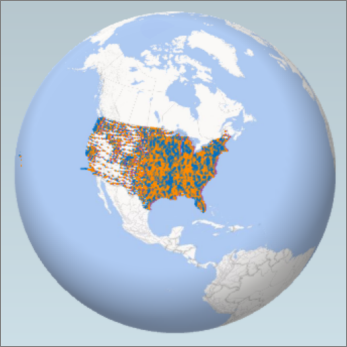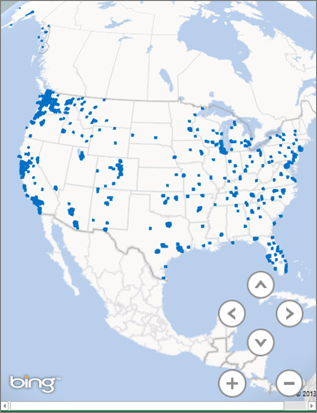Note: Power Map, our popular 3-D geospatial visualization add-in for Excel 2013, is now fully integrated into Excel. We’ve also given this feature a more descriptive name, “3D Maps". You'll find this functionality alongside other visualization features on the Insert tab.
Microsoft 3D Maps for Excel is a three-dimensional (3D) data visualization tool that lets you look at information in new ways. 3D Maps lets you discover insights you might not see in traditional two-dimensional (2D) tables and charts.

With 3D Maps, you can plot geographic and temporal data on a 3D globe or custom map, show it over time, and create visual tours you can share with other people. You’ll want to use 3D Maps to:
-
Map data Plot more than a million rows of data visually on Microsoft Bing maps in 3D format from an Excel table or Data Model in Excel.
-
Discover insights Gain new understandings by viewing your data in geographic space and seeing time-stamped data change over time.
-
Share stories Capture screenshots and build cinematic, guided video tours you can share broadly, engaging audiences like never before. Or export tours to video and share them that way as well.
You’ll find the 3D Map button in the Tours group, on the Insert tab of the Excel ribbon, next to the Charts group.
Create your first 3D Map
When you have Excel data that has geographic properties in table format or in a Data Model—for example, rows and columns that have names of cities, states, counties, zip codes, countries/regions, or longitudes and latitudes—you’re ready to get started. Here’s how:
-
In Excel, open a workbook that has the table or Data Model data you want to explore in 3D Maps.
For information about using your own data, see Prepare your data for 3D Maps.
If you don’t have data to explore yet, try downloading one of our sample datasets.
-
Click any cell in the table.
-
Click Insert > 3D Map.
(Clicking 3D Map for the first time automatically enables 3D Maps.)
3D Maps uses Bing to geocode your data based on its geographic properties. After a few seconds, the globe will appear next to the first screen of the Layer Pane.
-
In the Layer Pane, verify that fields are mapped correctly and click the drop-down arrow of any incorrectly mapped fields to match them to the right geographic properties.
For example, make sure that Seattle is recognized as a City in the drop-down box.

-
When 3D Maps plots the data, dots appear on the globe.

Explore sample datasets in 3D Maps
Our sample datasets are a great way to try out 3D Maps. Just download one of the following workbooks that already have the necessary geo-spatial entries you need to get started:










